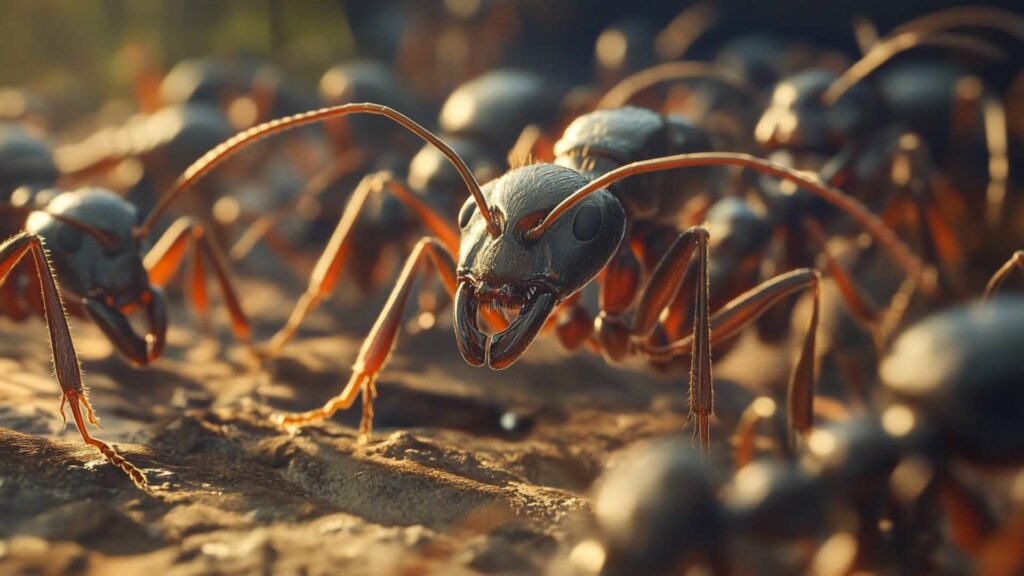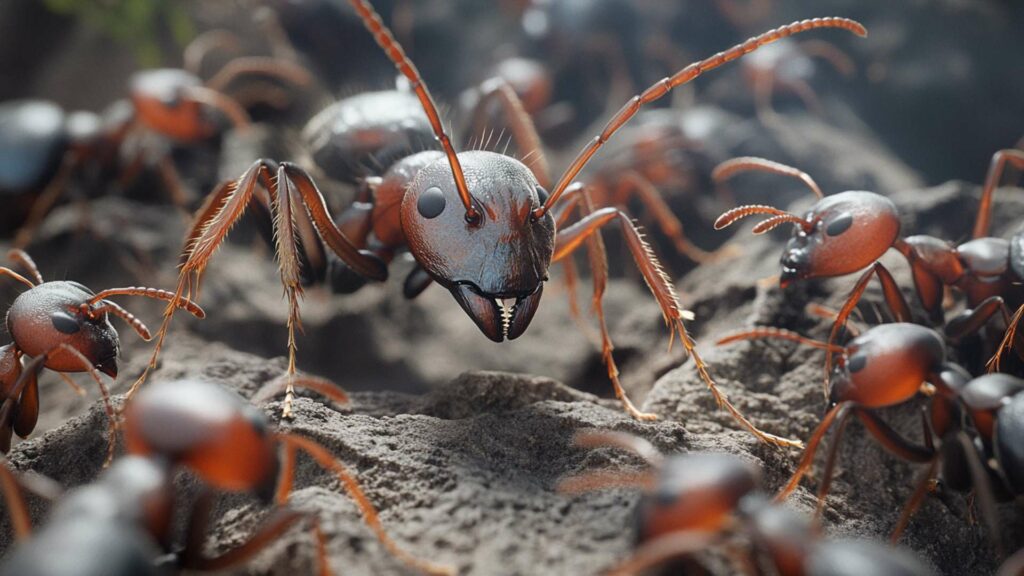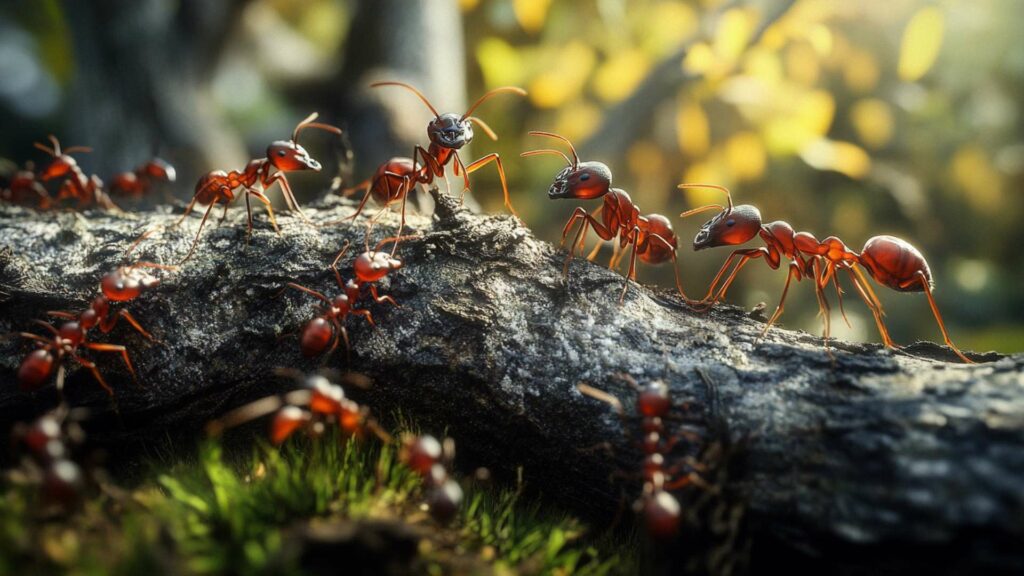In the intricate world of ants, queen ants hold a position of utmost importance. These regal insects are the heart and soul of their colonies, serving as the matriarchs that ensure the survival and growth of their bustling communities.
The queen ant is the reproductive powerhouse, responsible for laying eggs that give rise to all other members of the colony. Unlike regular worker ants, which are typically sterile females, queen ants’ males possess developed reproductive organs and have the unique ability to produce offspring.
Importance of Queen Ants in Colony Survival

A colony’s reliance on its queen cannot be overstated. Without a healthy and productive queen ant, a colony is at risk of dwindling or even collapsing altogether.
The primary role of a queen ant is to lay eggs continuously, ensuring the birth colony has a constant supply of new workers to carry out essential tasks such as foraging for food, expanding the nest, and caring for larvae. The presence of a strong and prolific queen also plays a vital role in maintaining order within the colony.
By releasing pheromones into their surroundings, queens communicate with other ants and regulate caste development. This chemical messaging system helps coordinate tasks among different members while promoting unity within the colony.
Queen ants are truly fascinating creatures that drive the success and longevity produce millions of their colonies. Now let’s delve deeper into understanding just how big these remarkable insects can grow.
General Characteristics of Queen Ants

When it comes to size, queen ants reign supreme within their colonies. These majestic creatures are significantly larger than the regular worker ants, who scurry around attending to various tasks.
In fact, the size difference between a queen ant and a worker ant is quite remarkable. While worker ants typically measure around 1 to 5 millimeters in length, queen ants can be several times bigger.
Depending on the species, queen ants can range from a modest half-inch (12 millimeters) to an astonishing two inches (50 millimeters) in length! The disparity in size between queens and workers is not just limited to length; it extends to other dimensions as well.
Queen ants possess a more robust and sturdier build compared to their smaller counterparts. Their bodies are plump and well-rounded, often featuring a distinctive thorax that sits atop a wider abdomen—a stark contrast from the slender physique of regular worker ants.
Physical appearance and distinguishing features
Distinguishing a queen ant from other members of the ant in the colony is crucial for understanding their role within the intricate social structure. One key feature that sets queens apart is their wings—yes, you read that right!
Unlike male ants or workers who shed their wings after mating flights, queen ants retain theirs throughout their lives. These delicate appendages allow them to take flight during nuptial swarms where they mate with male ants from different colonies.
Another notable characteristic of queen ants is their impressive egg-laying capacity. The abdomen of a mature queen ant is visibly larger than that of regular worker or female worker ants—almost resembling an egg-laying factory!
These formidable beings have specialized organs inside them solely dedicated to producing millions of eggs over their lifespan. One cannot ignore the regality exuded by these grand matriarchs of the ant world.
Queen ants often possess a distinguished appearance, with their exoskeleton exhibiting a glossy or even iridescent sheen. Their coloration can vary depending on the species, ranging from shades of black and brown to vibrant hues like red and yellow.
Queen ants are not only larger than regular worker ants; they stand out in terms of physical appearance and unique features such as wings and egg-laying capabilities. Understanding these distinctive characteristics is essential to identifying a queen ant within a colony and appreciating their significant role in ant behavior and colony dynamics.
Size Variations Among Different Species of Queen Ants
Largest known species of queen ants

When it comes to the largest queen ants, one remarkable example is the Asian bullet ant (Paraponera clavata). These queens measure an impressive 1.5 inches in length and can weigh up to 1 gram! Imagine encountering such a colossal ant in your backyard.
Another fascinating giant is the Florida carpenter ant (Camponotus floridanus), with queens reaching about an inch in length. These queens are truly a sight to behold, towering over their smaller relatives.
Measurement and weight comparisons
To put things into perspective, let’s compare these majestic queens with regular worker ants. While worker ants typically range from 0.1 to 0.5 inches in length, queen ants can be several times larger.
In terms of weight, worker ants usually weigh between 1 and 5 milligrams, while queen ants can reach up to hundreds or even thousands of times that weight! This size disparity underscores the crucial role played by queen ants as the reproductive powerhouse within ant colonies.
Examples from diverse ant families
Queen size varies not only between different species but also within the same family of ants. Take the leafcutter ant (Atta spp.), for instance; their queens are considerably larger than regular workers and measure around half an inch long. On the other hand, some harvester ant species (Pogonomyrmex spp.) have relatively modest-sized queens that are only slightly larger than their workers.
Smallest known species of queen ants
While there are giants among queen ants, some species boast minuscule queens that may surprise you with their tininess. For instance, certain parasitic ant species have miniature queens measuring just a few millimeters long! These queens are so tiny that they can easily be mistaken for regular worker ants.
One example identify a queen ant is the slave-making ant (Polyergus breviceps) queen, whose length ranges from 3 to 5 millimeters. Another small-sized queen is the thief ant (Solenopsis molesta), with queens measuring around 2 to 3 millimeters.
Measurement and weight comparisons
When comparing these petite queens with regular worker ants, the difference may not be as striking as with their larger counterparts. Regular worker ants in most species range from 1 to 10 millimeters in length, often falling within a similar size range as these diminutive queens. However, what makes these small queens stand out is their reproductive capabilities and distinct anatomy, allowing them to establish colonies of their own.
Examples from diverse ant families
The world of ants never ceases to amaze us, and examples of tiny queen ants can be found across various ant families. For instance, some species of pharaoh ants (Monomorium pharaonis) have queens that are only around 2 millimeters long.
Likewise, certain species of fire ants (Solenopsis spp.) have miniature queens that measure about 3 to 4 millimeters in length. Despite their smaller size compared to other queen ants, these diminutive monarchs play a vital role in perpetuating their respective colonies.
Factors Influencing the Size of Queen Ants
The nutrition and diet that queen ants receive during their larval development play a crucial role in determining their adult size. As the future matriarchs of ant colonies, queen ants require an ample supply of nutrients to support their growth and reproductive capabilities. Larvae that are fed with a nutrient-rich diet tend to grow larger and have a higher chance of becoming queens.
In contrast, larvae that receive limited nutrition may develop into smaller worker ants. The food composition and quality during this critical stage directly impact the ultimate size of the queen ant.
The larval stage is where the foundation for an ant’s adult size is established. Adequate nutrition during this phase enables the larvae to reach their maximum growth potential.
The more nourished the larvae are, the larger they grow, resulting in bigger adult Queen ants. Conversely, insufficient nutrition can stunt their growth and lead to smaller queen ants or even worker ants instead.
Examples of specific nutrients affecting size
Certain nutrients have been found to have a significant impact on the size of queen ants. Proteins, for example, are essential for muscle development and growth regulation in insects. A protein-rich diet facilitates larger body sizes in queen ants by providing them with sufficient building blocks for their tissues.
Similarly, lipids or fats play a crucial role in energy storage and reproductive processes. Queen ants with access to high-fat diets tend to be larger than those deprived of such resources.
Carbohydrates also contribute significantly to ant growth as they are essential for energy production during metamorphosis. Overall, it is clear that a balanced combination of proteins, lipids/fats, and carbohydrates is necessary for optimal growth and development in queen ants.
Environmental factors affecting size
Apart from nutrition, several environmental factors can influence the size of queen ants. Temperature and humidity are two critical abiotic factors that greatly impact ant development.
Warmer temperatures generally accelerate metabolic rates, resulting in faster growth and larger sizes. Likewise, higher humidity levels create more favorable conditions for larval development and support better growth.
The impact of these environmental factors on growth rate is significant. Queens developing in warmer climates tend to reach maturity earlier than those in cooler regions, giving them an advantage in size and reproductive potential.
Conversely, colder temperatures can slow down development and restrict the final size of queen ants. Similarly, adequate humidity promotes optimal growth by providing the necessary moisture for metabolic processes.
The size of queen ants is influenced by various factors such as nutrition during larval development and environmental conditions like temperature and humidity. The availability of specific nutrients affects their growth trajectories, with proteins, fats/lipids, and carbohydrates playing vital roles in determining their ultimate size.
Furthermore, temperature and humidity directly impact the speed at which queen ants develop and their final size. Understanding these influences sheds light on how ant colonies achieve different sizes of queens with diverse reproductive capacities.
Special Cases: Gigantism and Dwarfism in Queen Ants
In the world of ants, gigantism and dwarfism are not just concepts restricted to the human realm. It is not uncommon to encounter queen ants that deviate from the typical size range observed in most ant species. These special cases can be divided into two categories: giants and dwarfs.
Gigantism in queen ants occurs when an individual surpasses the normal size expected for its species. Imagine stumbling upon a colossal carpenter ant queen, much larger than any of its workers!
Such anomalies can leave anyone astonished. On the other end of the spectrum, there are dwarf queen ants that exhibit a significantly smaller size compared to their usual counterparts.
Possible causes for these abnormalities
The reasons behind gigantism and dwarfism in queen ants are still not fully understood, but several factors have been proposed as potential drivers of these abnormalities. One possible cause is genetic mutation, which can lead to changes in hormone levels responsible for growth regulation.
Another factor could be environmental conditions during larval development, such as nutrient availability or temperature fluctuations. Additionally, there is evidence suggesting that competition within ant colonies may play a role in determining the size of queen ants.
In colonies with multiple queens, each vies for dominance by laying more eggs than her rivals. As a result, individual queens might invest more energy into reproduction rather than growth, leading to smaller sizes compared to colonies with just more than one queen each.
Regardless of the underlying causes, gigantism and dwarfism among queen ants showcase the incredible diversity within these fascinating insects. They serve as reminders that nature always holds surprises beyond what we might anticipate.
Adaptations Related to the Size of Queen Ants
Queen ants, often the largest ants in a colony, possess a majestic stature that comes with its own set of advantages and disadvantages. Their large sizes grant them several benefits in managing their ant colonies.
Firstly, their sheer size provides an intimidation factor, deterring potential predators or rivals from challenging their authority. This advantage contributes to maintaining order within the colony and ensuring that all the egg’s and queen’s needs are met without disturbance.
Additionally, their size enables them to have larger storage organs for food reserves, ensuring they can survive extended periods without foraging. The ampler body also allows greater space for ovaries, enabling queen ants to produce numerous eggs efficiently.
However, along with these privileges come some drawbacks. The substantial dimensions of queen ants render them slower and less agile compared to smaller worker ants.
This impediment limits their mobility within the same ant nest or during migration if necessary. Moreover, large queen ants require more energy to move due to increased mass and longer appendages, which can make them vulnerable when it comes to escaping from imminent danger or evading predators swiftly.
On the opposite end of the spectrum lie small-sized queens – a marvel in themselves due to their ability to establish thriving ant colonies despite their diminutive stature. Small queens have distinct advantages suited to their size constraints.
For instance, small queens can navigate narrow crevices or compact tunnels more easily than their larger counterparts. This agility permits them access to hidden resources or safer nesting locations that might be inaccessible for giants among queen ants.
Moreover, smaller queens often benefit from higher reproductive rates as they require fewer resources for sustenance compared to their larger counterparts. Their efficient metabolism allows them to allocate more energy towards producing offspring, leading to rapid population growth in the initial stages of a new colony or establishment.
However, small queens face their own set of challenges. Their limited size restricts their egg-laying capacity when compared to producing eggs due to larger queens.
This limitation can impact the pace at which they expand their colonies and establish a stable workforce. In the vast realm of ant colonies, both queen sizes hold unique advantages and disadvantages, shaping the dynamics within these complex social structures.
Size Comparison between Queen Ants from Different Castes within Colonies
In an ant colony, the queen is undeniably the largest member. However, there can be substantial variations in size within different castes of ants.
Queens are typically much larger than workers and soldiers. While the precise measurements vary depending on the species, queen ants can range anywhere from a few millimeters to several centimeters in length.
On the other hand, worker ants are usually smaller and more compact, measuring only a fraction of the queen’s size. Soldier ants are often larger than workers but still relatively smaller compared to queens.
Explanations for variations in size within a single colony
The variations in size within a colony that comprises a single ant colony can be attributed to several factors. Firstly, genetics play a crucial role.
Genetic differences among individuals determine their growth potential and ultimately lead to variations in size. Additionally, nutrition also plays an important role in determining an ant’s size within a colony.
Larvae that receive abundant food resources during their development tend to grow larger compared to those with limited access to food. Another significant factor influencing size variation is social hierarchy within the ant colony.
The queen’s primary function is reproduction, so her body needs to be large enough to accommodate eggs and develop rapidly for efficient egg-laying. Workers, on the other hand, have specialized tasks such as foraging for food sources or taking care of larvae and maintaining the nest structure.
The division of labor ensures that each caste has specific body features suited for its assigned tasks in the parent nest. For instance, worker ants possess strong mandibles for collecting food or defending the nest against intruders.
Soldiers have even larger mandibles designed primarily for defense purposes. ,
the variations in size between queens, workers, soldiers, and other types of ants within a colony are driven by a combination of genetic factors, nutrition availability,
and the specialized roles each caste fulfills within the ant society. Understanding these size differences can provide valuable insights into the social structure and functioning of ant colonies.
Interesting Facts about the Size of Queen Ants
Did you know that the largest ant species in the world, the infamous carpenter ant (Camponotus gigas), can have a queen that measures up to 30mm in length? That’s longer than your average house key! These carpenter ant queens are dark brown and have powerful jaws, which they use to defend their colonies.
On the other end of the spectrum, we have some smaller species like the thief ant (Solenopsis molesta) whose queens can be as tiny as 2mm in length. It’s incredible how such small creatures can play such crucial roles within their colonies.
One rarely known fact is that while most queen ants lose their wings only males and after mating during a nuptial flight, there are some species where females retain their wings throughout their entire lives. These winged queens continue flying and scouting for suitable new nest locations long after establishing their colonies.
This ability allows queen mates around them to explore new territories and create secondary colonies, contributing to population dispersal and expansion. Ever wondered how long a queen ant can live?
Well, it’s quite amazing facts remarkable! Some queen ants have been recorded living for over 20 years, continuously producing eggs throughout their lives.
This extraordinary longevity ensures the survival and growth of their colonies by constantly replenishing worker populations. The dedication and endurance of these incredible insects never cease to amaze!
Conclusion
Queen ants come in various sizes depending on species, with some reaching astonishing lengths while others remain incredibly tiny. The size differences among these fascinating insects contribute to a range of adaptations and behaviors within ant colonies.
From giant carpenter ants with formidable jaws to diminutive thief ants capable of infiltrating other colonies unnoticed, every queen plays a vital role in sustaining her own colony together. Although often unseen by human eyes, the queens are the lifeblood of ant colonies, constantly laying eggs and ensuring the survival and growth of their respective nests.
The world of queen ants is full of surprises and rarely known trivia, showcasing the diversity and wonders of these remarkable creatures. So, next time you come across an ant hill or witness a swarm in action, take a moment to appreciate the extraordinary individuals behind it – the queens that guide these bustling societies to success.
Dissuade Ants with D-Termination: Las Vegas’ Leading Pest Control Service!

If you’re contending with ant problems, D-Termination is ready to help. Our experienced team excels at discouraging ants, rejuvenating cleanliness, and preserving the integrity of your surroundings. Bid farewell to ants—opt for D-Termination for effective pest control today!
Get in touch with us at 702-919-6310 or visit dtermination.com to schedule your ant control service and regain your space from these unwanted pests.
Frequently Asked Questions:
Queen ants are often larger than worker ants, have distinctive body features, and are usually found inside the nest.
Seeing a queen ant is relatively rare because they typically stay within the nest.
A house ant queen is usually larger than worker ants but still relatively small compared to other ants.
Queen ants primarily remain inside the nest, and it’s uncommon to see them outside.








